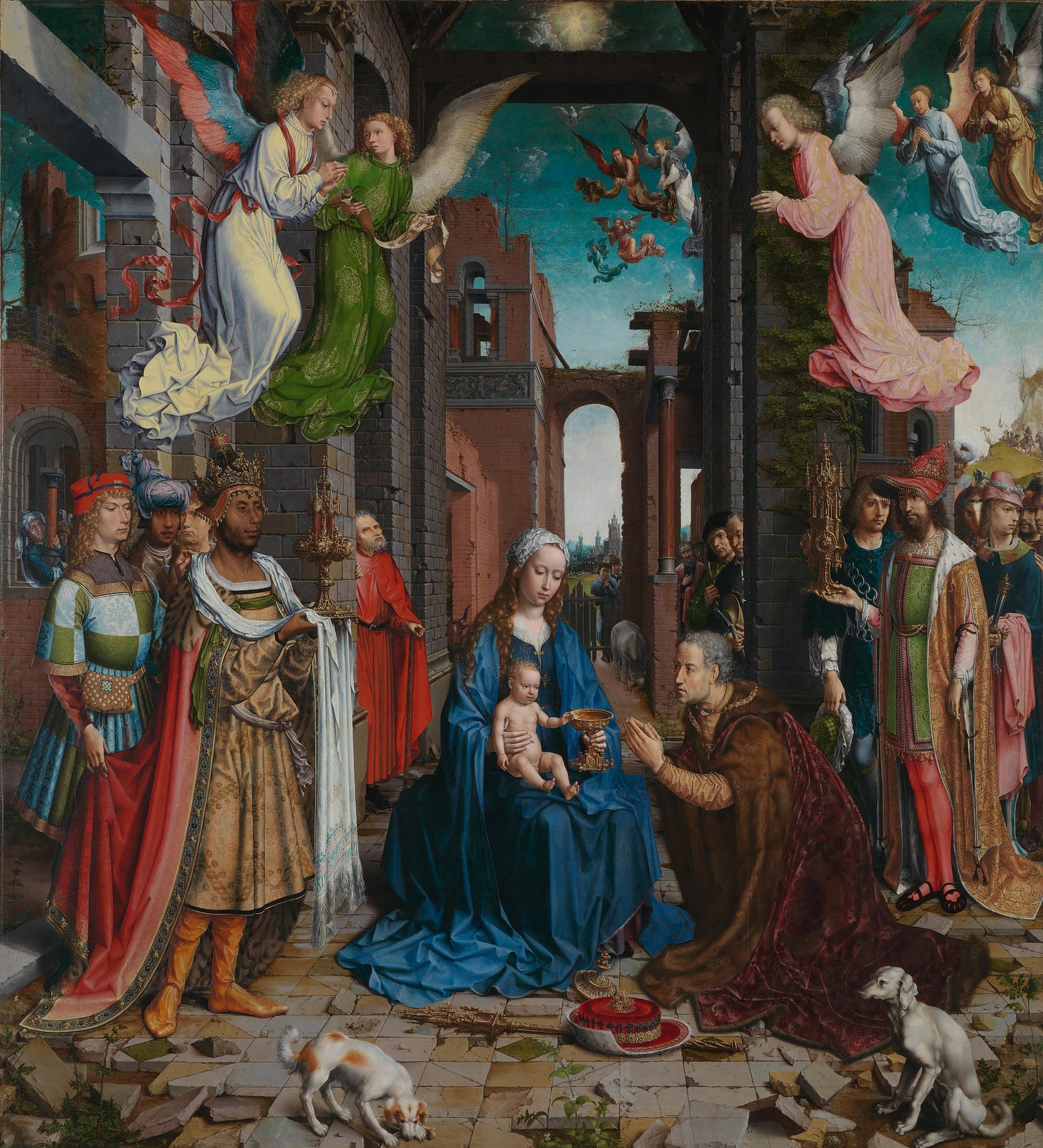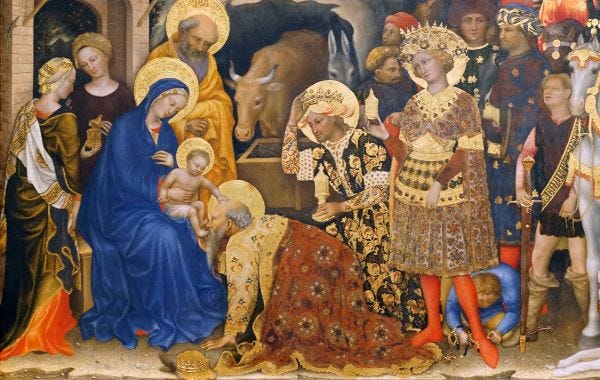Five Myths about Matthew's Magi
Have we got the epiphany all wrong?
We all know the story of the three kings who followed a star to find baby Jesus in Bethlehem. Kneeling before the Messiah, they offer him gifts of gold, frankincense and myrrh. On 6th and 19th January, Christians celebrate this event as ‘Epiphany’.
But what to we really know about these travellers from afar? How much of their story is fact, how much is fiction? And what do their gifts really mean? In this post, I go back to Matthew to expose five myths which these mysterious figures have accrued.
#1 They were Kings
The most common myth about Jesus’ visitors is that they were kings. Like many of our Christmas traditions, the popularisation of this idea owes more to Victorian England, with John Henry Hopkins Jr’s 1857 carol, We Three Kings, than it does to a close reading of Matthew. There in the Gospel, they are always magi – never kings.
John Calvin, the Protestant Reformer, was particularly incensed over the identification of the magi as kings. He attributes the invention of this connection to the Roman Catholic Church: “But the most ridiculous contrivance of the Papists on this subject is, that those men were kings... Beyond all doubt, they have been stupefied by a righteous judgment of God, that all might laugh at [their] gross ignorance.”1

In fact, the equation of the magi with kings long predates Roman Catholicism, and was an easy mistake to make. Tertullian had already described the magi as ‘wellnigh kings’ (fere reges) in the second century,2 likely drawing upon the imagery of Psalm 72: ‘The kings of Tharsis and the islands shall offer presents; the kings of the Arabians and of Saba shall bring him gifts: and all the kings of the earth shall adore him.’
While Psalm 72 has often been read as a song about Gentile-gift giving for the Messiah, however, it offers no evidence for the kingship of Matthew’s magi.
#2 There were Three of Them
Another popular misconception is that there were three magi. Again, our primary source only refers to the magi in the plural, which engendered variations from two to twelve. The idea that there were three seems to have been inferred from the three kinds of gifts offered to Jesus, and became the dominant tradition in the West.
As with the magi’s invented kingship, this idea that they were three was conjured early on. It is already assumed in a number of patristic writers as well as early Christian iconography. For example, the fourth-century sarcophagus relief below shows three magi with their camels, each bearing a gift in hand.
Where they were thought to be three, it became possible to give the magi a more specific character. For example, from at least the seventh century, the Latin tradition knew the magi under variations of the names Caspar, Melchior, and Balthasar. In the medieval period, a time of growing trade, it became common to identify the magi with different regions of the east: Caspar with India, Melchior with Persia and Balthazar with Arabia or Ethiopia.
In Matthew’s narrative, however, it is not clear precisely where the magi are from in ‘the East.’ Babylon (modern-day Iraq) and Arabia were common conjectures in antiquity. Yet a perhaps more attractive possibility is Persia (modern day Iran), where the magi were a hereditary priestly class of the Zoroastrian religion.
Tantalisingly, Zoroastrian myth imagined that a bringer of salvation, the Saošyant, was to be virgin-born. If we read Matthew in light of this story – a procedure which is somewhat precarious, given the later dating of the Zoroaster myth3 – it is possible that the magi’s journey contains a nod to Zoroastrian theology.
Conversely, Matthew may have kept their homeland deliberately vague. Perhaps the magi are more generally from ‘the east’ to show them as the first fruits of a more worldwide acceptance of Christ, a theme later expressed in his Great Commission.
#3 They Followed a Star
A more shocking misconception about the magi is that they followed a star.
While Matthew does describe the magi following a star (aster), a closer look at its behaviour reveals that this is no normal star. What exactly could it mean for a star come to ‘go before’ the magi? And how could it have ‘stopped over’ a place (Mt 2:9)?
There have been various attempts to solve the problem of the star. Perhaps the most promising of these explanations is offered by a Cambridge physicist, Colin J. Humphreys, who has argued that the bright object was in fact a ‘comet’ in 5 BCE.4 This would explain how the ‘star’ moved through the sky and was seen more than once.
Yet such scientific speculations struggle to explain how a comet could guide the magi to a precise location. They are also made redundant by an ancient understanding of stars. As Dale Allison points out, ancient cultures did not see stars as we do today – as inanimate masses, millions of light years away – but as living beings. Judaism also shared such ideas, viewing stars as ‘sons of God’ or angels.5
Reading the star as an angel – a bright living being, which can descend from heaven to earth, guide the magi on their way, and rest over a place – solves the mysteries of Matthew’s star. The reading is also attested in the apocryphal narrative, the Arabic Gospel of the Infancy, where the magi are guided by ‘an angel in the form of a star.’
#4 The Meaning of the Gifts
Even if the magi’s journey has to be slightly rethought, the meaning of their gifts seem to be on more stable ground. In the traditional interpretation, the gold represents Jesus’ kingship, frankincense his divinity and myrrh his death.
The instinct of this interpretation is a good one. Often, an infancy narrative will anticipate later aspects of the subject’s life. For example, Luke’s adolescent Jesus in the Temple foreshadows his later debates with scribes. And in the case of the magi, we have seen that they are the first fruits of a more worldwide reception of Christ.
But is the traditional interpretation correct? The first two gifts are redolent of Isaiah 60, where ‘the wealth of nations’ bring ‘gold and frankincense’ (v6). Gold, myrrh and frankincense are also connected in Jewish literature to David’s most famous son, King Solomon. As far as kingship goes, the traditional interpretation rings true.
Where the symbology falters is myrrh as an omen of Jesus’ passion. As Allison and William Davies have observed, the crucified Jesus in Mark drinks ‘wine mingled with myrrh’ (15:23). Instead of following this connection, however, Matthew changes Mark’s text to ‘wine mixed with gall’, following Psalm 68:22 (LXX).
Thus, at the very point where we might expect Matthew to reinforce the image between myrrh and Jesus’ death, he takes the symbolism in a different direction.
#5 They Found Jesus in Bethlehem
The final myth about Matthew’s magi is the most controversial of all: that they found Jesus in Bethlehem. This is problematic, not only because Bethlehem is historically contested as the birthplace of Jesus, but because there are reasons to question whether the magi’s subplot ever occurred. Here I will highlight just two.
First, Matthew’s story is embedded in an interpretive framework which few of us share today. Whatever we might think about God, theology or the ultimate nature of the universe, the question of whether a star – or an angel – guided magi from the east seems well beyond the pay-grade of the modern historian. Even if it could happen, which I accept, what reliable method would show that it did?6
Second, it is suspicious that magi appear in other ancient birth stories, similar to the one we find in Matthew. Thus, they feature in Herodotus’ account of the King Cyrus, as well as Plutarch and Cicero’s accounts of the birth of Alexander the Great. In all their tales, the magi serve to confirm the greatness of the ruler-to-be.
The presence of magi therefore appears to be a ‘stock’ feature of the birth stories of ancient heroes. It is what we would expect if an early Jesus follower was filling in the gaps of Jesus’ birth – an event which few presumably knew anything about. In this view, the myths of the magi may stretch as far back to the evangelist himself.
The Magi as History & Myth
Matthew’s story of the magi has accrued many myths to the point that the original picture is almost completely blurred: there were not three kings, they weren’t following a star, their gifts did not portend Jesus’ death and – perhaps most crucially of all – they likely did not find Jesus in Bethlehem. For most critical historians today, Matthew’s story of the magi is not historically true. It is a myth.
We must be careful, however, in dismissing the story of the magi as untrue in every sense. In fact, I think that the magi point to a truth – the Gentile reception of Christ – which has come to pass in a way that would have astounded even Matthew.
When Matthew wrote his Gospel, there were perhaps no more than seven or eight thousand Christians.7 Christianity was a marginal sect. Today, it is the largest religion in the world, comprising nearly a third of the world’s population. Many of the great pagan religions came – quite literally – to bow before Jesus, the infant Messiah.
As we encounter the story of the magi, then, there is a sense in which we encounter the story – not of first-century history – but of world history. We ‘Gentiles’ are the magi, and the worldwide celebration of epiphany embodies the truth of their myth.
Further Reading:
Dale C. Allison Jr., “What was the star that guided the magi?”, BAR, December 1993.
Commentaries, Vol. 31.
Adv Marcion, 3.8.
See M. David Litwa, How the Gospels Became History: Jesus and Mediterranean Myths (London: Yale University Press, 2019), 105.
Colin J. Humphreys, “The Star of Bethlehem, A Comet in 5 BC and the Date of Christ’s Birth,” Tyndale Bulletin 43 n. 1 (1992): 31-56.
As evidence of this belief, Dale Allison cites the following texts: Job 38:7 Daniel 8:10; 1 Enoch 43:1–4, 86:1–6, 90:20–7; Pseudo-Philo, Liber Antiquitatum Biblicarum 32:15; Joseph and Aseneth 14; Revelation 1:20, 9:21, 12:4; Testament of Solomon 20:14–7; 2 Enoch 29; and Babylonian Talmud, Avodah Zarah 43a–b; 3 Enoch 46. See Dale C. Allison Jr., “What was the star that guided the magi?”, BAR, December 1993.
What seems obvious to historians, whatever their theological persuasion, is that many stories of angels told in ancient Jewish literature are just that: stories. This weighs against this one as an occurrence of historical fact.
See, for example, David C. Sim, “How many Jews became Christians in the first century? The failure of the Christian mission to the Jews,” HTS 61 (2005): 417-440.





Good article! Have you read Eric Vanden Eykel's "The Magi?" Another important contribution on this topic